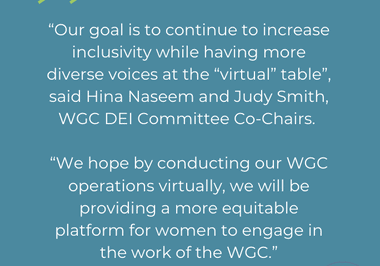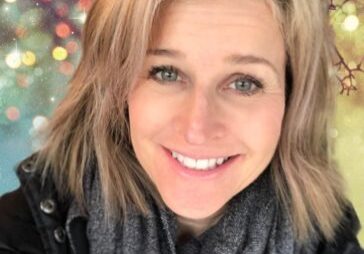WOMEN WHO START RUNNING LATER IN LIFE
FIND IMPROVED HEALTH AND CAMARADERIE
STORY BY Anne Haddad PHOTOGRAPHY BY Mary C. Gardella
SEPTEMBER /OCTOBER 2015
When Diane Johnston was growing up, her sturdy build and tendency to be overweight meant 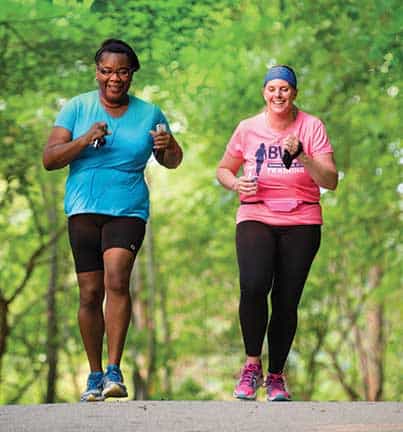
“If there was a position for which you didn’t have to run much, and you could stand there and block something, I would get sent there,” says Johnston, now 48, of Ellicott City. In her 20s and 30s, her weight increased to more than 200 pounds. She didn’t exercise regularly at all during those years. But after the birth of her youngest child, now 10, Johnston decided she had to improve her health. She lost 85 pounds and started running. Initially the running was to support the Jingle Bell 5K to raise money for rheumatoid arthritis, which her mother has.
Early this year, when Johnston received an email message asking whether she would help coach a running group for the Baltimore Women’s Classic 5k race, she assumed the sender had mixed her up with a “real” runner. She had trained with a Charm City Run program, looking to the coaches for guidance. Now, they were asking her to guide the incoming crop of newbies. Like Johnston, some of these women were just beginning to dare to think that yes, maybe they were born to run. They’re just late bloomers.
Johnston still has to remind herself daily that she’s become a real runner, even after finishing her first marathon last fall.
“I never thought I would be a runner – not in a million years,” Johnston says. “I still feel new to the sport – it gives me pause to think of myself and the words ‘sports’ or ‘athletics’ in the same sentence.”
For Johnston, the important thing was to train with a group and a coach who gave her measurable steps to take toward her goal, culminating in the full 26.2 miles of the Baltimore Marathon last fall. But it was the honor of passing along her experience to women new to running that has meant the most to her.
“To put on a shirt that has the word ‘coach’ on it, that was a transformative experience for me,” Johnston says. “[It] trumps any medal put around your neck.”
MORE WOMEN RUN
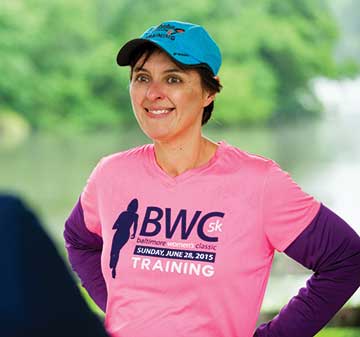
to the RunningUSA.org 2013 biannual survey, the average age of women who finished a timed road race was 34.8 years old, and 24 percent of all women in these races were 45 years or older. The average male-female ratio for all races is 57 percent women to 43 percent men. In 1990, only 25 percent were women.
As more evidence builds that running and other high-impact activities are the best kind for building bone density, it’s no longer a stretch for a woman of a certain age to start running.
For Johnston, health and stamina were her main motivation to lose weight and run. She has young children as well as a widowed mother whose mobility is limited by rheumatoid arthritis. She wants to be strong enough to take care of her mother as needed.
FROM LAB TO LAPS
Erin Strovel, 44, of Columbia, is also a volunteer coach for the Women’s Classic training group that meets every spring in Centennial Park. Strovel is an assistant professor of pediatrics at the University of Maryland School of Medicine and director of the Pediatric Biochemical Genetics Laboratory. She spends most of her day in a lab full of spectrometers and other specialized instruments, diagnosing and studying disorders such as Tay-Sachs disease, cystic fibrosis and PKU.
“I had done kickboxing classes off and on,” Strovel said. “I never really ran, though, unless I was chasing my two kids.” They are now 9 and 14.
“When my youngest was 5, I decided it was time to do something just for me. I 
Running was just the thing to offset long days in the lab.
“There was no pressure, no stress,” she says. “We just went at our own pace and did the best we could. We started off slow and built in walk breaks.”
She still takes a walk break now and then. It’s always the beginning of a run that is the hardest for her, she says. “If I can get through the first 2 to 3 miles, I don’t need to take a walk break,” she says.
“I met a lot of great people through my training groups who run. I did a 10k, and then I got roped in to doing the Maryland Half Marathon.” She’s done a few more half marathons since then. “I just think it’s a great stress reducer for me getting outside and a fun social time,” she says. “The Disney Princess Half Marathon was possibly the most fun I’ve ever had exercising.”
Recently, Strovel hurt her back and had to take a break from running for a few months. “Now, I’m building back my strength,” she says. Like the scientist that she is, Strovel approaches her running workouts with a mixture of intuition, logic and a little patience.
“I’m good at dialing it back if I have to and taking it slowly,” she says. When she sees people pushing through an injury, she worries that they may be making things worse. “Healing is a process, and you need to give your body a chance to repair itself,” she says. “I’m very methodical. I try to be logical about this. I’m not pushing my luck.”
Strovel recommends that women who run learn the difference between the soreness that indicates they’re working hard and will gain muscle and the pain that signals an injury. If it’s the latter, she says, the runner should see the doctor and consider asking for a referral to a physical therapist.
“But first make sure you have the correct shoes for you,” she says.
Physical therapists can help runners correct subtle problems in gait that can show up as pain in the heel, back or knee; the source might be a weak core and underused glutes. Whatever it is, physical therapists are good at figuring it out quickly and teaching runners to correct it.
STARTING TO RUN AT AGE 60
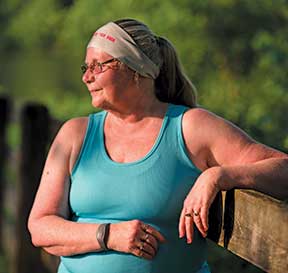
“I was never athletic,” Burke says. She works as a receptionist for ATI Performance Products, which makes parts for race cars. Her own preferred method of racing is walking fast, at about 15 minutes per mile. Two years ago, when she was 60, she was out on one of her fast walks and wondered what it would be like to start running.
“I said to myself, ‘Why don’t you just try it?’ ” She did. That first time, she says, “I don’t think I did it for more than 30 seconds.”
Gradually, running got easier. “Every five minutes, I would run for as long as I felt like running – usually a couple of minutes,” she says. It was hard, but she could do it. She started adding a few short running intervals to her walks. “I was actually surprised I could run,” Burke says. “I don’t really like to run. I love to walk, and I walk really fast.”
She’s thrilled to be able to run even a little and plans to keep up the intervals during her walks.
In April 2014, Burke underwent surgery and radiation therapy to remove a cancerous tumor in her breast. The doctors and others on her care team warned that the radiation could leave her fatigued but encouraged her to keep up as much of her exercise routine as she could.
“They told me to keep up the exercise daily, and I did. I was not fatigued at all,” she says.
A FAMILY THAT RUNS TOGETHER
Sheri Keller, 48, a special education teacher who lives in Columbia, never had to worry about her weight, although she did notice herself gaining a few pounds after she turned 40.
“I wasn’t fat, but I wasn’t strong either. I was often lethargic and tired,” Keller says. “I used to get up at the last possible minute to get ready for work – sometimes 7 a.m. Now, I get up at 5:15 to go to boot camp class, but I have more energy during the day.”
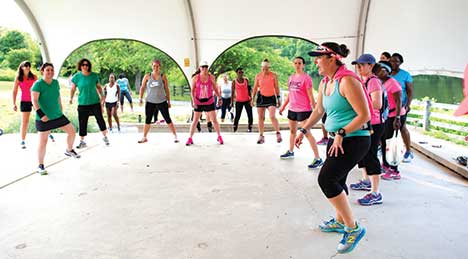
“I wouldn’t say it was pretty, but I did finish the Disney half-marathon,” says the self-described “slow runner.” Keller took a few walk breaks and finished in three hours and 17 minutes. “I’m OK with that,” she says.
But while she loves to actually run, she finds it a challenge to get out and do it because of her schedule and responsibilities.
“I sometimes have a hard time making myself get out to run, but it’s because I am busy with other things,” Keller says. “But once I’m out there, I really enjoy it.”
She sometimes runs with her husband or her older daughter, but they have surpassed her in pace by now, and so she is fine letting them run ahead if they want. She volunteers with Girls on the Run, and runs with her niece to help school-age girls train for a 5k race. And she sometimes enjoys running alone.
“I like to think while I’m running. Sometimes I come up with my best lesson plans while I’m running – ideas of what to do,” she says. “I don’t usually listen to music, but if I do, I put only one earbud in so that I can hear what’s going on around me.”
Keller and most of the women interviewed are very aware of safety, and a springtime incident in which a woman was assaulted in Centennial Park has them all on guard, although the suspect was arrested.
If Keller doesn’t feel safe running outside alone – if it’s dark, or very hot, for example – she goes to the Columbia Gym and runs on a treadmill.
She had one injury – a stress fracture in one of the bones of her foot – and had to wear a boot brace for two months, but recovered and started getting up to speed again.
Now, she and her husband are looking at a possible trip to California for a Disneyland race.
ONCE A RUNNER
Among the runners in the training group are a few who had been athletic as teens, but had not run since high school.
“I lettered in track in high school,” says Lisa Long, 46, of Mount Airy. So how could she be enrolled in a “beginning runner” group? “I was a sprinter. I never did distance.” Long stopped running after high school, and over the years put on weight.
As the popularity of 5k races grew around her, she decided to start running again in 2011 and enrolled in the training program for the Women’s Classic in 2012. By the end of 2012, she had lost 40 pounds.
Long still retains a sprinter’s instinct, tending to run at a pace her body couldn’t sustain for three miles – or even one mile – and then having to slow down periodically to a walk to catch her breath. She would walk up a hill, then run again, fast, until she had to slow to a walk again. She is less likely to take a walk break if she’s in a race or otherwise running with a group.
“Last year was the first time I ran the whole [Baltimore Women’s Classic] 5k,” she says. *
TOP 5 TIPS FOR LATE-BLOOMING WOMEN RUNNERS
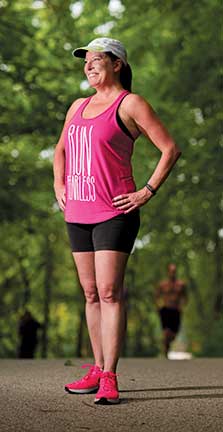
Invest in two important things: the right shoes and the right running bra. Buy from a store that will not only fit you properly but will let you return them in a reasonable amount of time if they don’t work out for you.
Motivation: Pick a 5k race that sounds appealing to you and is about eight weeks away, then find a training program for the race. It is easier to start and stick with a running program if you have a group to support you and motivate you along the way. Consider getting a friend to sign up with you. With a firm goal, you’re more likely to stick to a training program.
Run, but don’t only run. Bike, swim or take a strength training class. A training program allows for strength training, including your core and upper body, which will help you run and prevent injury.
Don’t do too much too fast and don’t ignore injuries. Go at a pace that is comfortable and reasonable for you. Don’t concern yourself with how fast or slow everyone else is. Don’t ignore or try to run through pain. See a doctor if an injury persists. Don’t be shy about seeking someone specializing in sports medicine. But also refer back to Tip No. 1: The wrong shoes can cause lots of issues!
Stretch after each workout. Strengthen and stretch your hips and gluteus muscles. Weak or tight hips and “sleeping” glutes can cause other muscles to do more than their share, leading to pain in your knee, heel or the back of your thigh.


